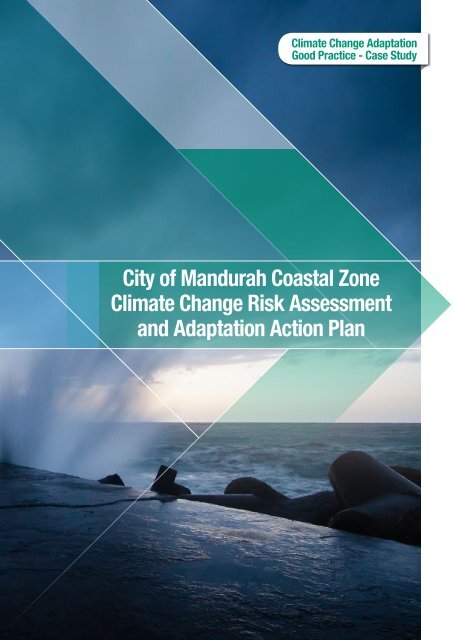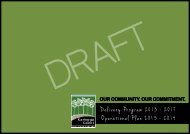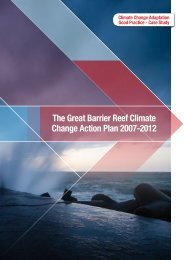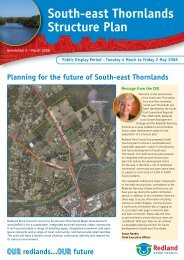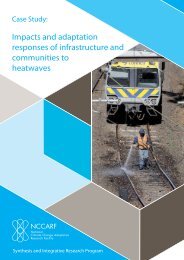City of Mandurah Coastal Zone Climate Change Risk Assessment ...
City of Mandurah Coastal Zone Climate Change Risk Assessment ...
City of Mandurah Coastal Zone Climate Change Risk Assessment ...
- No tags were found...
You also want an ePaper? Increase the reach of your titles
YUMPU automatically turns print PDFs into web optimized ePapers that Google loves.
<strong>Climate</strong> <strong>Change</strong> AdaptationGood Practice - Case Study<strong>City</strong> <strong>of</strong> <strong>Mandurah</strong> <strong>Coastal</strong> <strong>Zone</strong><strong>Climate</strong> <strong>Change</strong> <strong>Risk</strong> <strong>Assessment</strong>and Adaptation Action Plan
About Adaptation Good PracticeAdapting to climate change is a relativelynew concept to many. It is importantto learn from practitioners who areundertaking adaptation activities that arebeginning to have tangible outcomes.Documenting examples <strong>of</strong> good practiceand identifying the criteria that makesthem work, enables those interested inadaptation to learn about how to takeaction.There are expectations that AdaptationGood Practice (AGP) includes a definitestart and finish to a project. Howeverclimate change practitioners’ experiencesshow that adaptation projects are <strong>of</strong>tensteps in longer learning journeys. Thereare no golden rules on how to adaptand <strong>of</strong>ten practitioners across Australiaare inventing the wheel that drives futureAGP. This case study <strong>of</strong> the <strong>City</strong> <strong>of</strong><strong>Mandurah</strong> <strong>Coastal</strong> <strong>Zone</strong> <strong>Climate</strong> <strong>Change</strong><strong>Risk</strong> <strong>Assessment</strong> and Adaptation ActionPlan is part <strong>of</strong> a series <strong>of</strong> 16 case studiesthat recognise exemplars for AGP inAustralia. Through the development <strong>of</strong>these stories <strong>of</strong> successful adaptationit was refreshing to see an emergence<strong>of</strong> similar experiences and challengesregardless <strong>of</strong> the project or location.A synthesis <strong>of</strong> these stories can beseen in the Synthesis Report ‘<strong>Climate</strong><strong>Change</strong> Adaptation Good Practice: Keylessons from practitioners experiences’,which which will help practitioners tounderstand that they are not alone intheir challenges and to see some <strong>of</strong> theclear lessons learned about what drivesgood practice in adaptation.Following the Snapshot there is a morein depth narrative <strong>of</strong> the experiences,learnings and network links to stimulatefurther engagements and knowledgesharing among the growing community<strong>of</strong> adaptation practitioners.This project was funded by the Australian Department <strong>of</strong> Industry, Innovation,<strong>Climate</strong> <strong>Change</strong>, Science, Research and Tertiary EducationFor further information contact:Department <strong>of</strong> Industry, Innovation, <strong>Climate</strong> <strong>Change</strong>, Science, Research and Tertiary EducationEmail: stakeholderrelations@climatechange.gov.auThe Adaptation Good Practice project was undertaken byD. Rissik and N. Reis from the National <strong>Climate</strong> <strong>Change</strong> Adaptation Research Facility.© Commonwealth <strong>of</strong> Australia (Department <strong>of</strong> Industry, Innovation, <strong>Climate</strong> <strong>Change</strong>, Science, Research and Tertiary Education) 2013. ISBN 978-0-9922764-2-3. This work islicensed under the Creative Commons Creative Commons Attribution 3.0 Australia Licence. To view a copy <strong>of</strong> this license, visit http://creativecommons.org/licenses/by/3.0/auThe Department <strong>of</strong> Industry, Innovation, <strong>Climate</strong> <strong>Change</strong>, Science, Research and Tertiary Education asserts the right to be recognised as author <strong>of</strong> the original material.The views expressed herein are not necessarily the views <strong>of</strong> the Commonwealth <strong>of</strong> Australia, and the Commonwealth does not accept responsibility for any informationor advice contained herein.Acknowledgements : Ailbhe Travers, Mr. Brett Brenchley from the <strong>City</strong> <strong>of</strong> <strong>Mandurah</strong> is gratefully acknowledged for his input to this case study. The information providedhere builds on a previous CoM leadership case study – ‘Benefit or Burden? How to lead a positive legacy in local climate change adaptation’ - compiled by NCCARF towhich Mr. John Gabrielson and Mayor Paddi Creevey contributed.
Case study snapshot<strong>City</strong> <strong>of</strong> <strong>Mandurah</strong> <strong>Coastal</strong> <strong>Zone</strong> <strong>Climate</strong> <strong>Change</strong> <strong>Risk</strong><strong>Assessment</strong> and Adaptation Action PlanNTNSWACT<strong>Mandurah</strong> has one <strong>of</strong> the fastestgrowing populations <strong>of</strong> any Australianlocal government. It has a large 50 km<strong>of</strong> coast from Madora in the Northto Lake Clifton in the South and iscomprised <strong>of</strong> a local government area<strong>of</strong> 153.5 km 2 . Coupled with this, asignificant percentage <strong>of</strong> the populationgrowth is located in the coastal zoneand extensive canal estates. As a resultthe <strong>City</strong> was identified as one <strong>of</strong> fourmost vulnerable local government areasin Western Australia to the potentialimpacts <strong>of</strong> climate change (in the <strong>Climate</strong><strong>Change</strong> <strong>Risk</strong>s to Australia’s Coastpublication released by the AustraliaGovernment in 2009).Key climate change impacts for the areawere identified as rising sea levels, andchanges in the passage <strong>of</strong> storms, theirfrequency and intensity. <strong>Mandurah</strong>’s<strong>Coastal</strong> <strong>Zone</strong> <strong>Climate</strong> <strong>Change</strong> <strong>Risk</strong><strong>Assessment</strong> and Adaptation Action Planresults as pro<strong>of</strong> <strong>of</strong> the collaboration withincouncil with support from the Mayorand executive management. The climatechange team facilitated the focus onintegration and dissemination across allcouncil departments.The project journeyDeveloping a Local Adaptation PathwaysProject (LAPP) provided an importantfoundation to build adaptive capacityin the <strong>City</strong> <strong>of</strong> <strong>Mandurah</strong> (CoM) localgovernment area (LGA). The <strong>City</strong> hasacquired a solid reputation for addressingthe possible hazards and impacts <strong>of</strong> sealevel rise and storm surge events that areforecast to worsen with climate change.The LAPP ‘1st pass assessment’enabled the <strong>City</strong> to understand key risksand align these to a prioritised adaptationpathway. It provided a platform forcommunication and collaborationwith the local community and keystakeholders including state governmentdepartments. The LAPP also laid thefoundation for increased engagementacross different departments withinthe LGA and highlighted the needfor a mainstreamed approach toadaptation that moved away from themore traditional siloed approach toenvironmental management.Most importantly, the LAPP provided theimpetus for the CoM to advance theirongoing adaptation portfolio to includea strategy for climate sensitive localplanning. Their work to produce guidancefor developers undertaking vulnerabilityand adaptation assessments, andsupport for the local developmentapprovals process within the <strong>City</strong> isboth innovative and proactive and hasprovided inputs to help shape the WestAustralian state coastal planning policy(SPP 2.6).<strong>Mandurah</strong>WASAQLDVICTASSource: <strong>Coastal</strong> <strong>Zone</strong> Management Pty LtdFigure 1: Location <strong>of</strong> <strong>City</strong> <strong>of</strong> <strong>Mandurah</strong> LocalGovernment Area.
The projectThe prioritisation <strong>of</strong> risks gave an important roadmap for further investigation and initiatives.Drivers <strong>of</strong> adaptation action• The <strong>City</strong> has a strong history <strong>of</strong>awareness and action with respect to<strong>Climate</strong> <strong>Change</strong> Adaptation with theinitial LAPP project 2009• Significant investment in coastalinfrastructure and extensive areas <strong>of</strong>canal estates and waterways• Ecological significant areas; the coastis a cultural and socio-economicbackbone <strong>of</strong> community.4Reflect1Research and<strong>Assessment</strong>and PlanningDecision making2Adaptation action<strong>Mandurah</strong>’s <strong>Coastal</strong> <strong>Zone</strong> <strong>Climate</strong><strong>Change</strong> <strong>Risk</strong> <strong>Assessment</strong> andAdaptation Action Plan allowed councilto integrate climate change into theirbusiness plans and to provide supportand collaboration for other councils.Implementation3Outcomes achievedThe LAPP project formed the basis foran ongoing climate change adaptationportfolio for the <strong>City</strong>. The prioritisation<strong>of</strong> risks gave an important road mapfor further investigation and initiatives.The project provided a backdrop foran ongoing strategy <strong>of</strong> risk based localplanning and has acted as an impetusfor development <strong>of</strong> a climate sensitivetown planning process. Findings <strong>of</strong> thestudy have also served as an importantcommunication tool internally within thelocal government and externally with keystakeholders and the community.Figure 2: <strong>City</strong> <strong>of</strong> <strong>Mandurah</strong> <strong>Coastal</strong> <strong>Zone</strong> <strong>Climate</strong> <strong>Change</strong> <strong>Risk</strong> <strong>Assessment</strong> and AdaptationAction Plan Adaptation Good Practice phaseEmerging outcomesInternal capacity building for localgovernment <strong>of</strong>ficers through involvementin the LAPP and subsequent initiativessuch as involvement in the PeronNaturaliste Partnership (PNP) <strong>Coastal</strong>Adaptation Pathways (CAP) Project hasbeen an additional useful outcome.<strong>Climate</strong> <strong>Change</strong> Adaptation Good Practice (AGP) project 4
The projectThe projectThe CoM has a strong focus on takingaction to address climate change. The<strong>City</strong>’s commitment is reflected in theirStrategic Plan, plus development andimplementation <strong>of</strong> climate change plansincluding <strong>Coastal</strong> <strong>Climate</strong> <strong>Change</strong> <strong>Risk</strong><strong>Assessment</strong> and Adaptation Action Planand <strong>Climate</strong> <strong>Change</strong> Response Plan. Theinitial LAPP project was undertaken in2009 and was funded by the AustralianGovernment with additional supportfrom the CoM. The <strong>City</strong> is also a partyin the Peron Naturaliste Partnership(PNP). The PNP is a collaboration <strong>of</strong> ninelocal governments to provide a regionalmechanism for effective and timelyadaptation responses to climate change.It has recently completed a <strong>Coastal</strong>Adaptation Pathways Project fundedby the Australian Government, seeDeveloping Flexible Adaptation Pathwaysfor the Peron Naturaliste <strong>Coastal</strong> Region<strong>of</strong> Western Australia 2011 – 2012, in thisseries for further details.The LAPP completed by CoM served asa starting point to identify and prioritiseclimate change risks for the <strong>City</strong> and wasparticularly useful as a baseline studythrough its focus on both strategic andsite specific risk assessment.The LAPP has acted as an impetus forsubsequent activities that have led thecity to follow a pathway towards riskbased town planning decisions cognisant<strong>of</strong> climate change. Most recently this hasbeen seen through <strong>Mandurah</strong>’s initiativefor climate sensitive local planninginforming elements <strong>of</strong> the State PlanningPolicy.Source: <strong>Coastal</strong> <strong>Zone</strong> Management Pty LtdFigure 3: Canal estates and associated infrastructure at risk from erosion and elevated water levelsThe LAPP completed by CoM served as astarting point to identify and prioritise climatechange risks for the <strong>City</strong> and was particularlyuseful as a baseline study through its focus onboth strategic and site specific risk assessment.<strong>Risk</strong>s and impacts addressedThe climate change impacts consideredfor the purposes <strong>of</strong> the LAPP projectare summarised in Table 1. In particular,impacts <strong>of</strong> sea level rise and stormresponse to existing coastal infrastructureas well as land use planning will impedethe <strong>City</strong>’s ability to fulfil its organisationalobjectives across key local governmentsectors. These impacts will besuperimposed on already pressurisedcoastal, estuarine and channel systems.The output <strong>of</strong> the initial risk screeningprocess was a Strategic <strong>Climate</strong> <strong>Change</strong><strong>Risk</strong> Register that provided a list <strong>of</strong> risksper local government function for furtherassessment through the course <strong>of</strong> theLAPP study.<strong>Climate</strong> <strong>Change</strong> Adaptation Good Practice (AGP) project 5
The projectTable 1: <strong>Risk</strong> assessment parametersTimeframe 2070Sea-level risescenario100 Year OceanlevelTemperature+ 0.47 mRainfall (annual) - 19%Rainfall (spring) - 27%1.2 m to 1.67 mResponse strategy+ 2.7 °C;Days over 35 °C = 28 to 53The output <strong>of</strong> LAPP was a list <strong>of</strong>adaptation options prioritised forimplementation. The response strategiesdetailed in the LAPP have formed thebasis <strong>of</strong> the <strong>City</strong>’s ongoing programfor climate change adaptation. Theintegration <strong>of</strong> risk assessment outcomesinto business processes is alreadyvisible within the Council. Since theclimate change risk assessment wasundertaken, the Council has requestednumerous developers to conduct climatechange risk assessments to ensure theirdevelopment plans have consideredfuture climate change, with particularfocus on sea level rise. The <strong>City</strong> hasembarked on a process <strong>of</strong> generatinga locally relevant climate sensitiveplanning process and has contributed toamendments to State planning policy.Implementation phasesThe LAPP was implemented througha series <strong>of</strong> phases that aligned to theAustralian Greenhouse Office (AGO)which became the Department <strong>of</strong> <strong>Climate</strong><strong>Change</strong> “<strong>Climate</strong> <strong>Change</strong> and <strong>Risk</strong>Management: A Guide for Business andGovernment” report (AGO, 2006). TheAGO <strong>Risk</strong> Framework was supplementedwith components <strong>of</strong> international bestpractice with regard to vulnerabilityassessment and considerable advancesmade within Australia in the field <strong>of</strong>climate change risk management.The work carried out was undertakenat a focused scale to resolve issuessuitable for making coastal managementdecisions. It should be rememberedthat the AGO approach is focussed ongeneral/organisational risks. This is animportant differentiation as it is widelyrecognised that coastal response needsto be considered at relatively hightemporal resolutions. The subsequentapproach to the <strong>Mandurah</strong> Projectaimed to build on previous work carriedout in Western Australia for the Town<strong>of</strong> Cottesloe, for which a similar riskassessment process was used.An important next step for the CoM alongthe path to climate change adaptationwill be the elucidation <strong>of</strong> thresholds ortrigger points <strong>of</strong> the implementation<strong>of</strong> predetermined actions. These willnecessarily be based on the outcomes<strong>of</strong> monitoring climate performanceindicators (e.g. water availability, pestlevels, and changes in rainfall patterns).Outcomes achievedA key outcome from the work undertakenthrough the LAPP was the prioritisationthroughout the CoM local governmentarea to provide a roadmap for futureaction. These outcomes were usedby the <strong>City</strong> to both inform ongoingstrategic planning, and to engage andcommunicate with the wider communityon the subject <strong>of</strong> climate change.The LAPP acted as an impetus for CoMto engage with the State Government.With respect to climate change planningmatters in Western Australia (WA) it hasadvocated that current policies need tobe reviewed in response to uncertainfuture climate change impacts. Inparticular, CoM has been involved inthe provision <strong>of</strong> input to the WA StateGovernment recent review <strong>of</strong> State<strong>Coastal</strong> Planning Policy (SPP 2.6).<strong>Climate</strong> <strong>Change</strong> Adaptation Good Practice (AGP) project 6
The projectCoM <strong>Coastal</strong> <strong>Risk</strong> AssesmentApproachAGO <strong>Risk</strong> AssesmentApproachInitial decisionMoredetailedanalysisrequiredTreat nowPhase 1: Strategic <strong>Risk</strong> <strong>Assessment</strong> and Adaptation PlanStrategic <strong>Risk</strong> <strong>Assessment</strong>1. Set the context2. Sensitivity assessment3. Vulnerability assessment4. <strong>Risk</strong> assessment5. <strong>Risk</strong> prioritisationStrategic Adaptation <strong>Assessment</strong>1. Adaptation issues brief2. Conceptual mappingidentity options3. Strategic mapping andassessment develop plans andimplementSet the contextObjectives; Stakeholders; Criteria; KeyElements; <strong>Climate</strong> scenariosIdentify the risksWhat can happenHow could it happenAnalyse the riskReview controls; Likelihoods;Consequences; Level <strong>of</strong> <strong>Risk</strong>Evaluate the riskEvaluate risks; Rank risks; Screenminor risksTreat the risksIdentify options; Select the best;Develop plans; ImplementSet the contextObjectives; Stakeholders; Criteria; KeyElements; <strong>Climate</strong> scenariosInitial decisionTreat nowMoredetailedanalysisrequiredCollectmoreinformationPhase 2: Site Specific <strong>Risk</strong> <strong>Assessment</strong>and Adaptation PlanSite Specific <strong>Risk</strong> <strong>Assessment</strong>Analyses to gather more detailedinformationSite specific risk assessment TBDAdaptation <strong>Assessment</strong>3. Strategic Adaptation<strong>Assessment</strong>: identify options, selectbest, develop plans and implementIdentify the risksWhat can happenHow could it happenAnalyse the riskReview controls; Likelihoods;Consequences; Level <strong>of</strong> <strong>Risk</strong>Evaluate the riskEvaluate risks; Rank risks; Screenminor risksTreat the risksIdentify options; Select the best; Developplans; ImplementSource: <strong>Coastal</strong> <strong>Zone</strong> Management Pty LtdFigure 4: Implementation Phases in the LAPP aligned to the AGO risk assessment approach<strong>Climate</strong> <strong>Change</strong> Adaptation Good Practice (AGP) project 7
Lessons learntSource: Department <strong>of</strong> Planning and Infrastructure, 2008Figure 5: Example LAPP output illustrating areas identified as low, medium and high risk along the open ocean coast and estuary (<strong>Coastal</strong><strong>Zone</strong> Management Pty Ltd, 2009)<strong>Climate</strong> <strong>Change</strong> Adaptation Good Practice (AGP) project 8
Lessons learntCritical success factorsAGP analysis <strong>of</strong> the projectSuccess <strong>of</strong> this approach hasbeen driven by strong leadership,excellent connectivity between allstakeholders and a sustainablevision.This project is strong in:LeadershipConnectivitySustainabilityLeadershipThe <strong>City</strong> has a long history <strong>of</strong> leadershipwith respect to climate changesstemming from a resolution by the Mayor,which was unanimously endorsed byCouncil (on 20 November 2007). Thisresolution became a positive platformto meet with adaptation practitionersand researchers, who encouraged theCouncil to continue working on theissue. Importantly, it contained actionsand commitments for Council seniorstaff to display leadership on climatechange matters as well as a financialcommitment from Council to conducta risk assessment and subsequentadaptation planning.Leadership lesson learnt:Focused, shared leadership at thehighest levels within the organisationhas been the critical success factor inthe Council’s adaptive journey.EngagementThe CoM has maintained activeengagement with community and keystakeholders with respect to climatechange adaptation since it was firstidentified as an issue across the Council.This process began with an importantclimate change adaptation conferencein 2007, The <strong>Climate</strong> <strong>Change</strong> and theCoast Conference, which broughttogether a range <strong>of</strong> stakeholders andcommunity members. The initial driverfor the conference was the <strong>City</strong>’s strongrelationship with local researchersand consultants, who supported the<strong>City</strong>’s desire to explore the climatechange concerns facing its community.Throughout the <strong>City</strong>’s adaptive journey,the organisation has maintained an open,proactive attitude, and worked closelywith research organisations, universities,and national and state governmentbodies.Engagement lesson learnt:Access to the best scientific informationand national best-practice means theCouncil is able to make appropriateadaptive decisions.ConnectivityAn important success factor in the CoM’sjourney towards a climate-adaptedcommunity was the formulation <strong>of</strong> adedicated climate change team withinCouncil. The climate change teamwas instrumental in driving work in theCoM around adaptation, and in 2011,<strong>Mandurah</strong> drafted and adopted a climatechange response plan. The plan is a keydocument in moving forward with workat the Council resulting in integratingclimate change into subsequent businessplans. In addition, a significant degree<strong>of</strong> in-house capacity building has beenachieved through the active participation<strong>of</strong> council staff in the LAPP process andsubsequent initiatives. For example, therisk assessment process implementedthrough the LAPP has been emulatedto deal with the potential impacts <strong>of</strong>extreme heat on community health forthe CoM using tools and techniques withwhich council staff are now familiar.The <strong>City</strong> is a strong component <strong>of</strong> thePeron Naturaliste Partnership and hascontributed to the work being done at amulti-council scale. This connectivity willultimately result in an integrated regionalapproach to dealing with climate change.Connectivity lesson learnt:Create a dedicated climate changeteam within Council to connect with thecommunity.SustainabilityThe LAPP project has enabled <strong>Mandurah</strong>to become more aware and betterinformed through the evidence thathas been gathered, and to apply thePrecautionary Principle to filter its coastaladaptation response planning. The <strong>City</strong>is now in a better position to develop amore sophisticated rationale and argue(supported by good evidence) for acautionary approach to developmentapplications especially in high hazardzones.Sustainability lesson learnt:Become better informed bygathering evidence and applying thePrecautionary Principle to filter coastaladaptation response planning.<strong>Climate</strong> <strong>Change</strong> Adaptation Good Practice (AGP) project 9
ConclusionThe outcomes <strong>of</strong> the LAPP providedmany lessons for other local areas facingsimilar coastal hazards. The approachemployed by CoM was subsequentlyused by several other local governmentsin Western Australia with the <strong>Mandurah</strong>experience widely regarded asdemonstrating important elements <strong>of</strong>‘best practice’.The foundation laid by LAPP wasalso beneficial for the CoM in theirsubsequent involvement with the Peron-Naturaliste project. Through this regionalcollaboration, <strong>City</strong> staff were able toshare their experiences with respectto climate change adaptation andremain actively involved and engagedwith both the State Government andtheir counterparts across other localgovernments in the area. The partnershipwas successful in gaining fundingthrough the Australian Government’s<strong>Coastal</strong> Decision Adaptation PathwaysProgram. This collaborative approachis seen as a good model to addressconstraints and to promote localgovernment concerns in regards toclimate change.Gaps and future challengesThe coastal zone risk assessmentundertaken as part <strong>of</strong> the LocalAdaptation Pathways Program (LAPP),provided an indication <strong>of</strong> areasand levels <strong>of</strong> risk. However, it wasrecognised by the CoM that moredetailed locally relevant modelling anddata was required. This suggests thatdownscaled climate projections andhazard mapping should be a higherpriority. This information would not onlyaid in decision-making at the local levelbut in the provision <strong>of</strong> useful, relevantinformation to the community. This was inpart addressed through PNP.Furthermore, the provision <strong>of</strong> informationis <strong>of</strong>ten most effective in changingbehaviours if accompanied with otherinitiatives and /or intervention strategies.As such it is the view <strong>of</strong> the <strong>City</strong> that tobe most effective the provision <strong>of</strong>climate change information shouldform part <strong>of</strong> a larger initiative, whichincludes solutions to climate changeissues that empower the communityto take action under the leadership<strong>of</strong> all levels <strong>of</strong> government. Roles andresponsibilities for adaptation by StateGovernment, including in the areas <strong>of</strong>land-use planning, coastal management,and emergency management should alsobe clarified.10
NetworksLinks to more information and projects• www.mandurah.wa.gov.au/<strong>Climate</strong><strong>Change</strong>Strategy.htm• <strong>Climate</strong> <strong>Change</strong> <strong>Risk</strong>s to Australia’s Coast (2009) Department <strong>of</strong> <strong>Climate</strong> <strong>Change</strong>and Energy Efficiency. - www.climatechange.gov.au/publications/coastline/climatechange-risks-to-australias-coasts.aspx• <strong>Coastal</strong> <strong>Zone</strong> <strong>Climate</strong> <strong>Change</strong> <strong>Risk</strong> <strong>Assessment</strong> and Adaptation Plan(2009) <strong>Coastal</strong> <strong>Zone</strong> Management Pty Ltd. - www.mandurah.wa.gov.au/<strong>Climate</strong><strong>Change</strong>Strategy.htm• Coasts and <strong>Climate</strong> <strong>Change</strong> Council Report to Minister Combet (2011) Department<strong>of</strong> <strong>Climate</strong> <strong>Change</strong> and Energy Efficiency. - www.climatechange.gov.au/climatechange/australias-coasts-and-climate-change/adapting/coasts-and-climatechange-council/~/media/publications/coastline/cccc-report.pdf• www.nccarf.edu.au/content/city<strong>of</strong>mandurah• http://peronnaturaliste.org.au/?p=81The <strong>Climate</strong> <strong>Change</strong> Adaptation Good Practice project was funded by the Australian Government and delivered by NCCARF


